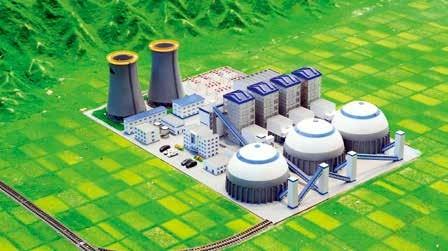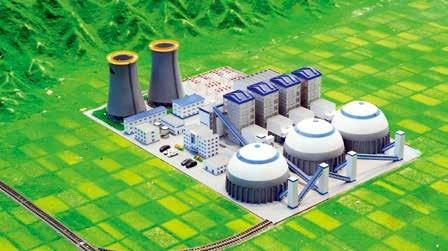How to Transform China’s Energy Industry Against the Backdrop of“Double Carbon”?
By Zhao Ailing

The Paris Agreement calls for measures to keep the rise in the global average temperature below 2°C above pre-industrial levels and aims to limit the rise to 1.5°C, according to a joint study released by the Boston Consulting Group (BCG) and the Global Financial Markets Association (GFMA). In order to achieve this objective, the global economy has to change. This has led to an inevitable trend in the green transformation of energy structures and industrial structures.
On July 27th, Ernst & Young released its latest report, which explores the structural transformation of high carbon energy sources and the challenges and opportunities brought about by the peak carbon dioxide emissions and carbon neutrality (“double carbon”) goals in the energy industry in the context of the continuous growth of energy demand driven by economic growth in China from the technical, financial and policy perspectives.
“Achieving peak carbon dioxide emissions and further achieving carbon neutrality must begin with the transformation of the energy structure, which is bound to have a significant impact on the future development of Chinas energy industry. Specifically, the transformation path of Chinas energy industry against this double carbon backdrop should be reflected in the technological assistance represented by clean substitution, electric power substitution, energy interconnection, energy efficiency improvements and carbon reduction technology, financial assistance including green finance and carbon trading, as well as policy support,” said Zhu Yaming, co-managing partner of Ernst & Young Energy and Resources Industry in Greater China and managing partner of Infrastructure Consulting Services in Greater China.
Technological innovation in the industry will generate new investment
At present, global carbon emissions are concentrated in the power generation and heating sectors. Taking China as an example, the carbon emissions of the sectors producing and supplying power, steam and hot water reached 51%, which was significantly higher than that of other sectors. This means that in order to achieve carbon neutrality, China need to accelerate the transformation and upgrading of its energy supply, which needs to make non-fossil fuel energy dominant, rather than fossil fuels as in the current energy system. According to the Renewable Energy Installed Capacity Data 2021 report released by the International Renewable Energy Agency, the global installed renewable energy capacity reached 2,799 gigawatts in 2020, up 10.3% from 2019. The installed renewable energy capacity saw an increase of more than 260 gigawatts. At the same time, the increase in installed traditional energy capacity fell to 60 gigawatts from 64 gigawatts in 2019. Countries such as Russia, the U.S., Azerbaijan, Georgia and Turkey have witnessed the decommissioning of hydrocarbon-based power generation facilities for the first time. It can be predicted that with the trend towards carbon neutrality, wind power generation, hydropower generation and photovoltaic power generation will become the dominated means of power supply in the future.

“The establishment of the double carbon goal and the formal acceptance of the Kigali Amendment (Montreal Protocol) reflect Chinas active response to climate change, demonstrate its responsibility as a great power and creates a forward-looking strategic significance in accelerating China economic and energy transition. China expects to have only 30 years from its carbon peak to carbon neutrality, and this period will be vital for comprehensive economic development, so the task will be even more urgent. By keeping its energy options open, we believe that China can find the best way to achieve carbon neutrality in the shortest time,” Zhu Yaming pointed out.
China ranks second in the renewable energy sector with a combined score of 68.7, and comes first in solar-thermal power generation and hydropower and second in photovoltaic power generation across the world. This reflects the fact that Chinas renewable energy investment market still has huge potential.
In terms of new energy installed capacity, Chinas total power installed capacity will grow to 3.8 billion kW by 2030, with clean energy accounting for 68% of the total. Clean energy installations will increase by approximately 1.6 billion gigawatts over the next decade at a compound growth rate of 10.5% from 2020 to 2030. Hydrogen energy storage is an important transformation direction for enterprises in the energy industry due to its advantages of being pollution-free, and having a high density, as well as wide sources and utilization. China is also increasing its input into hydrogen energy technology.
“China should strengthen guidance and encouragement regarding the hydrogen industry at the policy level, and international advanced experience can be taken as a reference for policy making in a bid to establish stable longterm development goals and encourage technological innovation,” said Zhong Li, Ernst & Youngs co-managing partner of energy and resources industry in Greater China and managing partner of auditing services in North China.
According to the report, the development of new energy technologies represented by photovoltaic and wind power generation requires not only breakthroughs in technology and equipment, but also support in terms of relevant policies. At present, the state has introduced a number of measures to actively promote the parity of Internet access, intensify financial support, ensure the collection of electricity prices, and provide additional funds for renewable energy and 100% additional levies for new projects in order to expand the source and scale of subsidy revenue.
Green finance will become an important way for countries to break the resource and environmental bottleneck constraints
Carbon pricing and carbon trading are another important market regulation mechanism used to achieve the“double carbon” goal, and carbon trading is mainly used for pricing in China.
“The national carbon trading market, which officially opened on July 16th, has drawn international attention as the worlds largest carbon market. If institutional arrangements for individual and institutional investors to participate in the carbon market are introduced in the future, more market participants will be attracted, which will effectively realize the active operation of the carbon market and lay a solid foundation for the innovation of carbon financial products,” said Li Jing, Ernst & Youngs greater China financial services climate change and sustainability partner and head of financial services sustainability in Asia Pacific. In addition, China is also actively exploring the construction of a carbon futures market. From international experience, carbon futures trading plays a significant role in promoting the return of carbon pricing to a reasonable range, standardizing trading, introducing more investors, helping emitters to grasp the mid- and long-term price trends, and hedging price risks. The construction and long-term development of the domestic carbon futures market are of great significance to the achievement of the “double carbon” goal and the transformation of the energy industry.
As intermediaries between supply and demand for capital, lenders, arrangers and investors, i.e. banks and capital markets, play a key role in global economic development. The successful mobilization of public and private capital in banks and capital markets to finance climate transition can only be achieved through effective mechanisms of cooperation between the public, society, the real economy and the broader financial sector. Therefore, the double carbon goal of green finance has come into being. Promoting the development of the green economy with green finance has become an important way to solve the resource and environmental bottleneck constraints.
While accelerating industrial transformation, the green energy transition is also fostering change in the financial sector. In recent years, the domestic green bond market has developed rapidly, showing the characteristics of stateowned enterprises as the main body, and issuers are constantly diversified, varieties are rich and transactions are active. Investors have shown a certain preference for green financial investment, and fiscal and monetary policies are gradually being implemented. An effective positive incentive mechanism is formed from the improvement of the top-level design to a series of detailed policies. Energy enterprises can use green finance business to finance and invest in qualified green projects, which can not only enjoy relevant preferential policies, but can also help to establish the companys brand image. At the same time, relevant environmental benefit information should be continuously disclosed to publicize enterprises efforts and development prospects to investors in terms of energy transformation.
Achieving carbon neutrality also requires a green tax regime to match. At present, China encourages the development of the industry through tax incentives; however, restrictive tax policies will force enterprises and the public to make timely adjustments. Lan Dongwu, Ernst & Youngs managing partner of energy and resources tax in Greater China said, “green tax policies should be further transformed and upgraded in combination with the ‘double carbon goal; lessons can be taken from international experience, and the domestic reality should be taken into account, so as to establish and standardize the green tax mechanism systematically; tax incentives should be increased for low-carbon emissions, as well as related technological development and transformation in eight sectors; there should be more restrictive taxes on producers and users of high carbon emissions; and tax revenue should be utilized to give a clear direction to economic benefits.”
- China’s foreign Trade的其它文章
- Fresh Food E-commerce Has Huge Potential for Development
- Housekeeping Service Industry Presents Super Opportunities for Investment
- China Becomes Top Machinery Exporter for the First Time
- Outlook for Investment from Insurance Institutions in the Belt and Road Initiative
- A Growing Market for Mobile Medical Apps
- China’s Game Industry Exhibits“Smile Curve”

